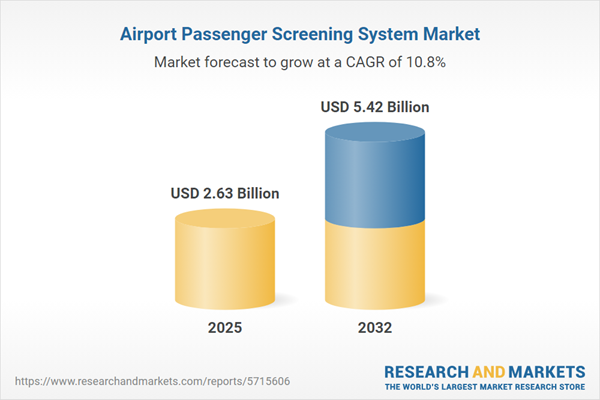Speak directly to the analyst to clarify any post sales queries you may have.
The airport passenger screening system market is evolving rapidly, driven by innovation in security technology, complex global regulations, and the urgent need for efficient traveler experiences. Industry leaders seeking competitive advantage must navigate shifting operational paradigms in a landscape shaped by dynamic threats, regulatory changes, and technology adoption.
Market Snapshot: Airport Passenger Screening System Market Growth and Opportunity
The airport passenger screening system market grew from USD 2.38 billion in 2024 to USD 2.63 billion in 2025. It is expected to maintain robust momentum with a CAGR of 10.84%, reaching USD 5.42 billion by 2032. The salience of this B2B segment stems from sustained growth in air traffic, intensifying security demands, and rising investment in next-generation detection solutions. Continuous technology upgrades, supply chain adjustments, and regional diversity further contribute to this market’s complexity and scale.
Scope & Segmentation
- Technologies: AI Video Analytics, Computed Tomography (including Dual Energy, 3D Imaging, and Material Discrimination), Single Energy Computed Tomography, Explosive Trace Detectors, Metal Detectors, Millimeter Wave Scanners, X-Ray Inspection Systems.
- Passenger Types: Business Passengers, Crew, Leisure Passengers, Transit Passengers.
- Screening Types: Automated Screening (In-Line, Off-Line), Manual Screening (Bag Search, Physical Pat Down).
- Checkpoint Locations: Arrival Terminals, Boarding Gates, Checked Baggage Areas, Departure Terminals, Security Lounges.
- Deployment Models: Permanent (New Build, Retrofit), Temporary (Event Based, Seasonal).
- End Users: Airlines, Airport Authorities, Private Contractors, Security Agencies.
- Regions and Key Countries: Americas (United States, Canada, Mexico, Brazil, Argentina, Chile, Colombia, Peru), Europe, Middle East & Africa (United Kingdom, Germany, France, Russia, Italy, Spain, Netherlands, Sweden, Poland, Switzerland, United Arab Emirates, Saudi Arabia, Qatar, Turkey, Israel, South Africa, Nigeria, Egypt, Kenya), Asia-Pacific (China, India, Japan, Australia, South Korea, Indonesia, Thailand, Malaysia, Singapore, Taiwan).
- Leading Companies: Smiths Detection Ltd, L3Harris Technologies Inc., Thales S.A., OSI Systems Inc., Leidos Holdings Inc., Analogic Corporation, Rohde & Schwarz GmbH & Co. KG, NUCTECH Company Limited, CEIA S.p.A., NEC Corporation.
Key Takeaways: Strategic Insights for Decision-Makers
- The growth trajectory emphasizes adoption of advanced imaging and machine learning for increased threat detection accuracy and operational efficiency across airport environments.
- Contactless and automated processes are gaining traction as stakeholders prioritize throughput and traveler safety while responding to evolving health and security challenges.
- Collaboration between airport authorities, airlines, and security agencies supports unified screening protocols and enhanced regulatory alignment, particularly in multi-jurisdictional regions.
- Agility in supply chain management and diversified sourcing strategies are vital, especially as global manufacturing and logistics networks adjust to shifting tariff policies.
- Segment-specific requirements—such as differentiation between leisure, business, and crew travelers—drive the customization of screening solutions and service delivery models.
- Integrated analytics platforms and unified data sharing are enabling dynamic resource allocation and proactive threat mitigation at critical checkpoints.
Tariff Impact: Navigating the U.S. 2025 Tariff Landscape
Recent U.S. tariffs on imported passenger screening equipment have introduced supply chain and procurement challenges. These developments are prompting suppliers and end users to reconsider sourcing, engage in long-term contracts, and explore domestic manufacturing partnerships. Market participants are optimizing their production and logistics to manage tariff exposure, while regional manufacturing hubs are emerging to serve adjacent markets with more resilience. Strategic agility is essential for maintaining screening performance and managing total cost of ownership in the face of new customs and capital allocation pressures.
Methodology & Data Sources
This report utilizes a rigorous methodology, combining primary interviews with industry professionals and in-depth secondary research from regulatory documents, industry whitepapers, and patent databases. Data integrity is further ensured through cross-referencing of results, supply chain intelligence, and expert panel validation, supporting reliable quantitative and qualitative insights.
Why This Report Matters
- Enables leaders to benchmark new technologies and regulatory trends for long-term investment planning and compliance assurance.
- Delivers actionable segmentation insights that support targeted deployment models and region-specific growth strategies.
- Helps decision-makers understand the operational and supply chain impacts of ongoing geopolitical changes, including tariffs.
Conclusion
This analysis offers a comprehensive understanding of the airport passenger screening ecosystem, empowering industry stakeholders to prioritize investments, ensure regulatory compliance, and optimize operations. Proven methodologies and actionable insights position organizations to adapt confidently in a rapidly changing global security environment.
Additional Product Information:
- Purchase of this report includes 1 year online access with quarterly updates.
- This report can be updated on request. Please contact our Customer Experience team using the Ask a Question widget on our website.
Table of Contents
3. Executive Summary
4. Market Overview
7. Cumulative Impact of Artificial Intelligence 2025
Companies Mentioned
The companies profiled in this Airport Passenger Screening System market report include:- Smiths Detection Ltd
- L3Harris Technologies, Inc.
- Thales S.A.
- OSI Systems, Inc.
- Leidos Holdings, Inc.
- Analogic Corporation
- Rohde & Schwarz GmbH & Co. KG
- NUCTECH Company Limited
- CEIA S.p.A.
- NEC Corporation
Table Information
| Report Attribute | Details |
|---|---|
| No. of Pages | 181 |
| Published | October 2025 |
| Forecast Period | 2025 - 2032 |
| Estimated Market Value ( USD | $ 2.63 Billion |
| Forecasted Market Value ( USD | $ 5.42 Billion |
| Compound Annual Growth Rate | 10.8% |
| Regions Covered | Global |
| No. of Companies Mentioned | 11 |









